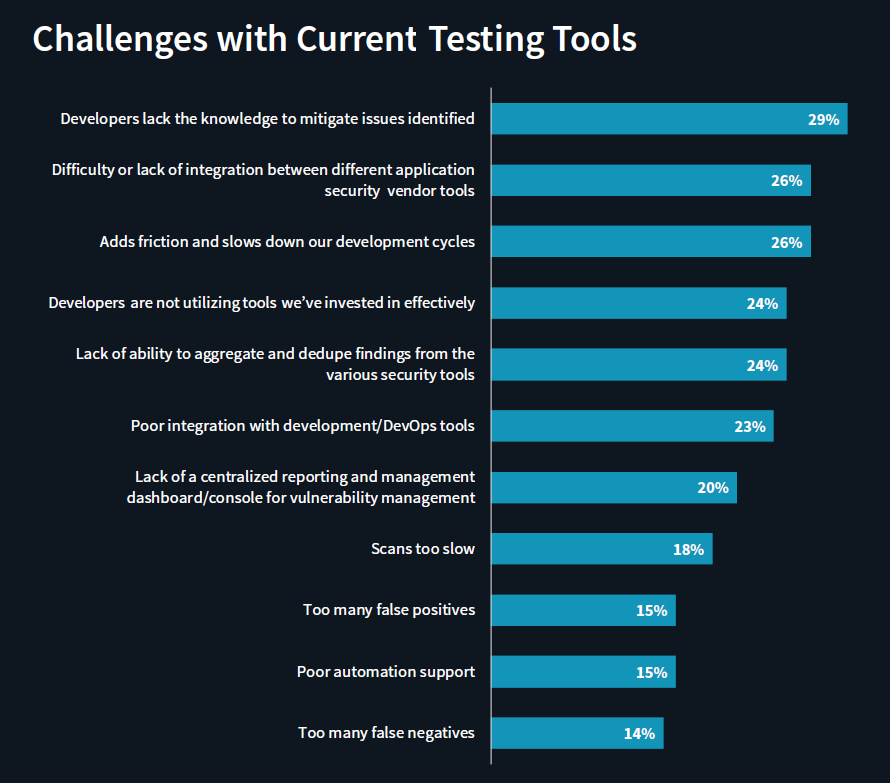webAI and MacStadium(link is external) announced a strategic partnership that will revolutionize the deployment of large-scale artificial intelligence models using Apple's cutting-edge silicon technology.
According to Forrester research, of 40 university computer science programs in the US, not one requires students to take secure coding or secure application design courses. That piece of the cyber skills gap means such training is often left up to individual teams.
Developers are not, and should not be expected to be, security experts.
Start with New Report: Speed and Security Are Both Possible in Software Development - Part 1
But to make DevSecOps more effective and address both the speed and security pressures, development and security teams need to understand each other better. For developers, that means understanding how applications can be exploited — the OWASP Top 10 is a good start.
ESG listed other elements of the most effective AppSec programs, several of which include better security awareness for developers. They include:
■ Application security best practices are formally documented.
■ Application security training is included as part of the ongoing development security training program.
■ Development managers are responsible for communicating best practices to developers.
■ A high percentage of developers participate in formal application security training programs.
■ Security issue introduction is tracked for individual development teams.
Then there is the technology piece, a major part of which is security testing tools.
Tools are crucial to finding design flaws, vulnerabilities in code and open source defects and licensing conflicts. Most organizations use multiple tools, but some of them have gone overboard — way overboard.
ESG reported(link is external) more than a year ago that organizations on average run 25 to 49 security tools from up to 10 different vendors. There's an industry term for it — "tool sprawl." And it can slow productivity and lead to higher overall costs — the very things a good mix of security tools should help development teams avoid.
Analysts like Forrester and 451 Research have reported on tool sprawl in the past year, noting that as many as 40% of organizations admit that their development teams are so overwhelmed by security alerts that they can't respond to at least 25% of them. Indeed, when security alerts are so constant, they become background "noise" and are ignored — the exact opposite of the intent.
Survey respondents are aware of the problem. "Nearly one-third of organizations are … planning future investment to consolidate and simplify their tools proliferation," the report said.
So, clearly one part of the solution is DevOps integration — finding the right mix of tools that can work together and are easy for developers to use. ESG found that, for organizations seeking to improve the security of their software, "the most common challenge with their current tools is that their developers lack the knowledge to (mitigate identified security issues)."

The other part is automation. "Most believe that automating application security testing throughout the SDLC can make the biggest impact on the success of their program. DevOps integration reduces friction and shifts security further left, helping organizations identify security issues sooner," the report said.
The obvious goal is to build both security and speed into the SDLC. And based on the survey results, organizations are willing to invest to achieve that. More than half reported plans to "significantly increase spending on application security over the prior year."
Which means there is at least a chance that at some point in the future, the market will indeed get software-powered products that are the latest, greatest — and also the safest.
Industry News
Development work on the Linux kernel — the core software that underpins the open source Linux operating system — has a new infrastructure partner in Akamai. The company's cloud computing service and content delivery network (CDN) will support kernel.org, the main distribution system for Linux kernel source code and the primary coordination vehicle for its global developer network.
Komodor announced a new approach to full-cycle drift management for Kubernetes, with new capabilities to automate the detection, investigation, and remediation of configuration drift—the gradual divergence of Kubernetes clusters from their intended state—helping organizations enforce consistency across large-scale, multi-cluster environments.
Red Hat announced the latest updates to Red Hat AI, its portfolio of products and services designed to help accelerate the development and deployment of AI solutions across the hybrid cloud.
CloudCasa by Catalogic announced the availability of the latest version of its CloudCasa software.
BrowserStack announced the launch of Private Devices, expanding its enterprise portfolio to address the specialized testing needs of organizations with stringent security requirements.
Chainguard announced Chainguard Libraries, a catalog of guarded language libraries for Java built securely from source on SLSA L2 infrastructure.
Cloudelligent attained Amazon Web Services (AWS) DevOps Competency status.
Platform9 formally launched the Platform9 Partner Program.
Cosmonic announced the launch of Cosmonic Control, a control plane for managing distributed applications across any cloud, any Kubernetes, any edge, or on premise and self-hosted deployment.
Oracle announced the general availability of Oracle Exadata Database Service on Exascale Infrastructure on Oracle Database@Azure(link sends e-mail).
Perforce Software announced its acquisition of Snowtrack.
Mirantis and Gcore announced an agreement to facilitate the deployment of artificial intelligence (AI) workloads.
Amplitude announced the rollout of Session Replay Everywhere.
Oracle announced the availability of Java 24, the latest version of the programming language and development platform. Java 24 (Oracle JDK 24) delivers thousands of improvements to help developers maximize productivity and drive innovation. In addition, enhancements to the platform's performance, stability, and security help organizations accelerate their business growth ...













